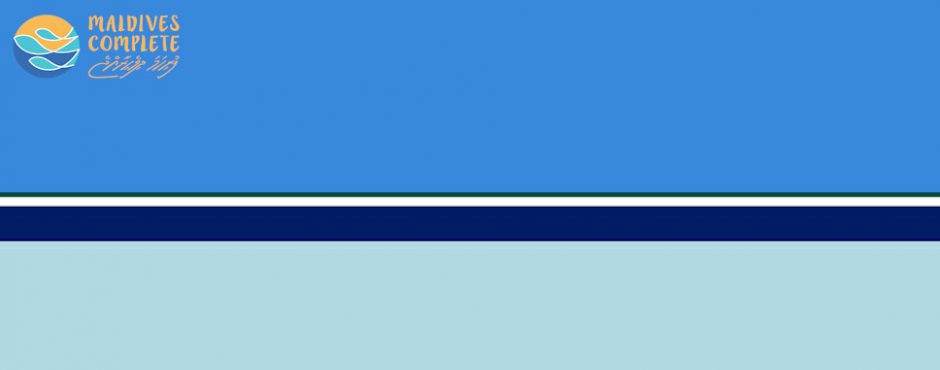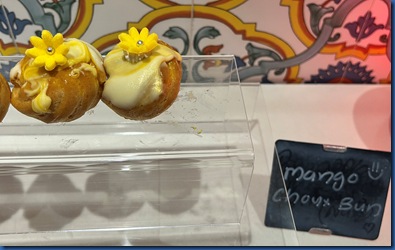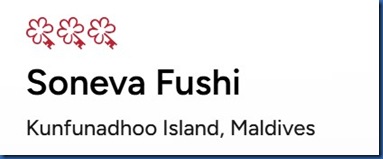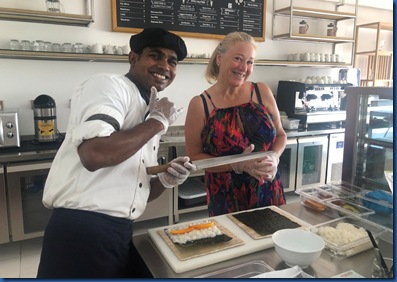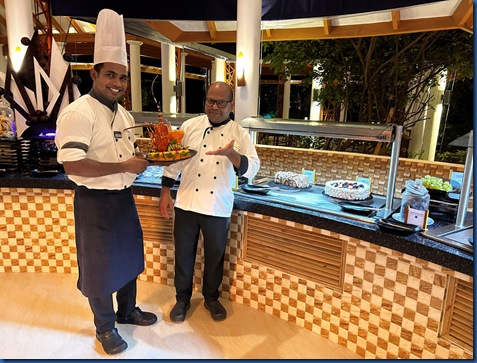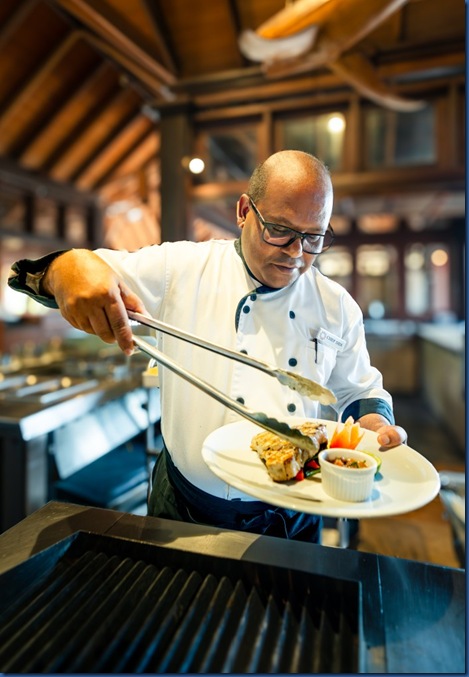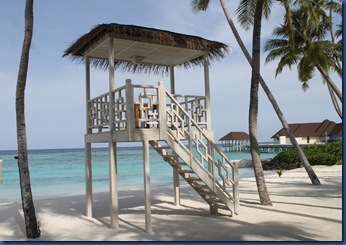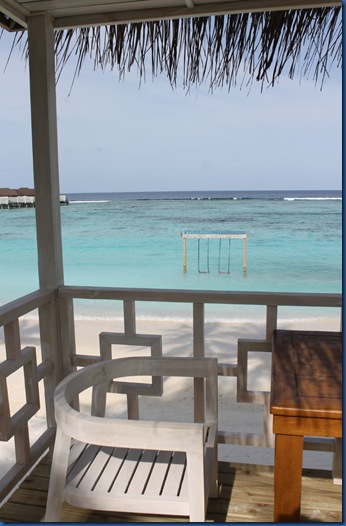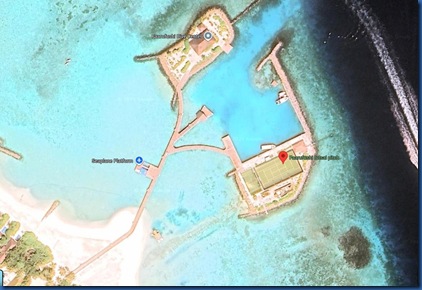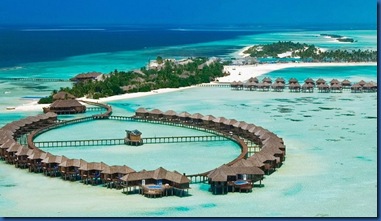When visiting the Maldives, I always a appreciate when the F&B has injected a bit of tropical twist to their often conventional offerings on the buffet spread. I was particularly fond of the Mango Chou at Joy Island featuring my fav tropical fruit.
Best of the Maldives: Michelin Star Quality – Soneva
In the rise of the super-luxury offerings in the Maldives, I’ve often mused when the gourmet outlets might someday reach Michelin star quality. Certainly, a few I’ve sampled seem to have reached that exalted bar, but the Guide simply didn’t cover the Maldives geography. A number of resorts have touted their guest chefs who bring with them Michelin-starred credentials.
Perhaps no one has had more Michelin-star chefs in their kitchens than Soneva. In fact, in partnership with the guide itself, they are hosting an unprecedented series of 10 starred chefs at their properties. Soneva not only has both of its Maldives properties featured in the guide, but they Soneva Jani receives an elite 2 stars and Soneva Fushi receives the coveted highest accolade of 3 stars (well “keys” for hotels) which translates to “worth a special journey”. Indeed, a very special journey!
Best of the Maldives: Sushi Making Class – Sun Siyam Olhuveli
Sun Siyam Olhuveli not only serves up amazing sushi, but also will teach you how to make it yourself at their sushi class. Taught by sushi chef (not to be confused with “sous chef”) Namal, he takes you through the process of making sushi, maki rolls and sashimi. Our son, Chase, once gave me a gift of such a class in London and it was as much fun as it was insightful. So, Lori did the classwork and I concentrated on quality control (to which I can attest she passed with flavourful flying colours). If you want a more pampered way to enjoy sushi, Olhuveli’s “Theo’s Coffee Shop” offers 100 varieties in total including a range of dessert sushi made with fruit.
Best of the Maldives: Lobster Sushi – Sun Siyam Olhuveli
This is not a “Haven’t Seen”, but it should have been. Lobster is the most iconic luxury seafood, and sushi is a delightful, light delicacy for the warm weather. The dish Sun Siyam Olhuveli’s Executive Chef Didi Hassan’s signature specialty. Specifically, it is lobster maki with lobster mousse and cream, topped with tobiko and salmon roe. TripAdvisor Forum Destination Expert Moirad tells me that Raffles also features lobster sushi, but they ae going to have to show me what they have to convince me that it could be more spectacular than this presentation).
Best of the Maldives: Veteran Chef – Sun Siyam Olhuveli
As the Maldives tourism industry matures, a number of veterans of the sector stand-out with some serious tenure. As the industry started dominated by ex-pat workers and management, Maldivian national veterans are a bit rarer. Sun Siyam Olhuveli’s Executive Chef Didi Hassan is the longest serving Maldivian I have met in the Maldives. He has been in the business for 32 years, 10 years of which have been at Olhuveli. That pedigree has given him a distinctive perspective on the evolution of the sector, milestone events (especially the tsunami of 2004), and insight into effective resort management and operations. I had the opportunity to sit down with him during my recent visit and glean some of these reflections.
How did you start your career?
I started my career peeling potatoes. I’m not even in the kitchen. I’m at the back door of the kitchen. I took an onion and garlic and started doing that. Then I after another month, I told my chef I wanted to go inside the kitchen. He gave me a chance and allowed me to come into the kitchen. He started by giving me a knife and doing some cutting. But he gave me a very unsharp knife. He said, “If I give you a proper knife, you’re going to cut your hand”…So I started cutting there. I tried to be very fast because my intention was to finish any thing I got to do as quickly as possible and then get something else to do.
How did you develop your culinary expertise?
I started hotel school training in culinary. I did learning little by little. But I had no target, no direction. But my direction was shaped by working in the kitchen. Back then you didn’t have phones, computers and laptops everywhere. We had one or two computers in the front office. If you wanted to do something on them, you had to go get permission. So, in order to learn, I started collecting magazines. When people checked out, they often left magazines behind. And there were lots of food articles. I would cut out all sorts of articles. This is part of learning. I would ask the room boys that if anyone leaves any magazine to give it to me. People would leave books to and any food-related book I would read.
In 1987 I was very young when I married. Me and my wife have had a very good connection from a very young time. Can’t say we were neighbors, but a not far from my home. We went to school and during that time I had some time to go work in a factory. In 1993, We got our first baby. And so that time ,I was here in Olhuveli. This is when I got serious in my work career. I thought about myself what I’m looking for in the industry. I decided my main target was to be an executive chef.
It was a very straightforward goal. Every year I checked how it was happening, what was happening, whether it is progressing or not progressing, figuring what is the next. Anytime I am on duty, I first person in the kitchen and last person in the kitchen. Because I know I have to show myself.
At 31, I became the chef at Oluhevli. We had only three restaurants. One is a buffet restaurant, one is a la carte restaurant and other one is a pool restaurant. At these three restaurants, we have a la carte restaurant and we have teppanyaki. I also worked for 5 years in teppenyaki. Back in 1993, there were no F&B managers like what we have now. But after about 2000, we started getting some high end resorts the operations got more sophisticated.
Do you cook for your family?
When I am visiting home, definitely, I will cook part of it. The children say, “Dad’s home! Please cook curry, chicken curry.” And they will ask for noodles, dry tuna noodles.” I also serve these dishes at the resort. I customize a lot of the local cuisine in the menus.
Do you have any advice for someone looking for a career in F&B?
Right now I manage 133 chefs. When I have interviewers, I ask “What’s your goal? What are you looking for? What is your vision?” You cannot get anything if you don’t put yourself into that goal that only you can achieve. Don’t give up any situation. Don’t look behind, go forward. My advice to anyone coming out of culinary school is first that you have to be punctual. To be on time. If the team isn’t on duty, we just can’t get the job done. Secondly, set your vision and mission as your target to be achieved and work for that.
What is your management style?
I don’t want anyone have a limit. So I don’t keep anyone to limit. You create what you think. Put what is on your mind on the plate or put on the paper and come and discuss it with me. I am looking for interesting dishes.
Do you have a chef’s garden?
The company has three agricultural islands. We decided on things like ladies fingers, eggplants, basils, mint, lemongrass as they are all very easy to grow. You can see that the soil is limited. When you dig it, after one foot, it will be salt water. It’s not easy to grow things, but I have still tried to plant in different things in different places like chili trees and lemon trees. So you become a bit of a farmer as well as a chef.
You were on the island during the tsunami. What was that like?
It was very early morning. And we had a huge departure scheduled with over 100 guests checking out and 90 guests arriving. So I came in very early that morning. I was with my breakfast team and I could see the huge lagoon (there was no Dream Island or Romance Island back then). Then, the whole air became totally different. It was like a feeling. Like a ghost. There was a kind of an unusual sound as well. Still we didn’t know what was going on, but you could see the darkness created. The wind direction changed, but still we are not seeing anything happening. Then when I saw the sea, there was no water. I asked our accountant, Barry, “What is happening?”
Then we had a very heavy strong ‘zoom’ sound. This started to feel a little bit scary. But still we didn’t know what was, but it felt scary. Still there was no water in the lagoon. It was totally empty. Then after that, you saw water start to come up from the sand. The water is boiling up like bubbles.
At that point, the ocean started coming in. First to the lagoon and then onto the island itself. At first, it was about 6 inches deep, but it pushed very strongly. You could not stand up. Then the water rose all the way up to the level of the restaurant roof! At the time, everyone was done with breakfast and people were out and about going to the beach, snorkeling, diving, doing activities. Then the second wave hit. It came in the same way, but this time it came from the side.
When it happened, an announcement was made for all the staff to go to the arrival area. We had almost 90 people on the jetty because the lagoon deck is a bit higher than anywhere else. Then we had security check every room to see if anyone was left there.
Fortunately, everyone was okay. We didn’t have any deaths though we had a few injuries. Immediately, we created a task force team. We divided into 4 or 5 groups. The powerhouse was shut down, but the computer system was still live. Somehow we were able to restart operations immediately.
Then it came to food. Most of our food stores were gone. Our chillers and freezers broke down, but they were floating on top of the water that came flooding in and they stayed sealed so a lot of that food was saved.
We collected all the tin items and checked whether we can use them. We arranged all the food we had. Engineering was working on restoring power. All the kitchen equipment was gone. Then we were able to do some cooking and the staff and the guest were fed together.
At this point we still didn’t know what was going on. We did start sending guests to the airport immediately. Some people had damaged passports from the water, but at that time the majority of rooms didn’t have safes so people kept their passports in the front office which kept them safe. By the following midnight, all the guests had left the island for the airport and only staff remained. But then the government sent guests to us who have gotten stranded. Almost 500 guests. 700 quarantine people in total.
The staff were allowed to go home if they could find a way to travel. We didn’t terminate any staff, but we couldn’t afford to pay them. We said you can stay here and we would feed and house them and give them some pocket money.
The people remaining all volunteered to help. We had a big task with all these things to do. And we had to feed 700 quarantined people.
You could walk freely, but you couldn’t come onto the island. There we police and military guarding the island entrance. We carried the food from the entrance and then we santise it.
Best of the Maldives: Raised Beach Dining Cabana – Sun Siyam Olhuveli
Two of the most distinctive aspects to the Maldives is the intimacy of the islands with the surrounding ocean, and the mesmerizing vistas of dappled blues. One of the most memorable ways to enjoy both is the iconic beach dining. Many resorts now set tables on the sand by the water or construct special cabanas for dining to provide a bit of shelter from the ocean breeze and occasional shower. Sun Siyam Olhuveli has taken the latter to literally the next level with an elevated cabana so you sea view is all the more dramatic.
Best of the Maldives: Island Futsal – Emerald Faarufushi
Any resort over 100k square meters will have a “football” pitch of sorts for their footie-mad staff (and a few footie fan guests as well). Typically, they are sequestered in the middle of the resort island amongst the staff facilities, but Emerald Faarufushi has graced its “futsal” pitch with a position right out in the middle of the lagoon.
Best of the Maldives: Sheltered Snorkeling Lagoon – Olhuveli
Lots of tropical destinations have islands with dappled blue water surrounding them, but one of the qualities that distinguish the Maldives is the mill pond tranquillity of these waters. The ringed atolls encircle a semi-protected region in the middle of the Indian Ocean which dampens the larger sea currents and swells of the open ocean. Especially, the shallow lagoons whose limited depth further mutes the volatility of the water.
This calmness not only contributes to the destination’s renown for languid relaxation, but also makes for some distinctively easier water enjoyment, especially snorkelling. The problem with snorkelling is that the lagoons are so sheltered that they don’t get the nutrient flow that current normally deliver and in recent years, they have gotten particularly warm both conditions of which impede the growth of coral.
But sometimes coral croppings do emerge which make for excellent beginner snorkeling. Sun Siyam Olhuveli has a sweet spot combination of no just one bur 2 sheltered lagoons with low-depth snorkeling. They are both on par with Kuda Huraa and Canareef that similarly impressed us years ago with their lagoon coral gardens, but Olhuveli has two, they are more sheltered and the one by the arrival jetty does have a drop-off at the end. We had one of our most memorable snorkels ever here on our previous visit with an octopus playing hide-and-seek with us.
Best of the Maldives: Sandy Water Villa Jetty – Joy Island, sand
Two of the distinctive joys of the Maldives are (1) “no shoes, no news” barefoot walking in soft sand everywhere, and (b) getting intimately close to the tranquil seas surrounding you made closest by their iconic water villas. But one first world problem is combining the two when tender bare feet step on the water villa jetties that have been baking in the tropical sun (ouch!). Joy Island has directly combined these two joys in a way that eliminates the first world problem – sand on the jetties!
